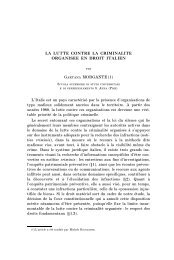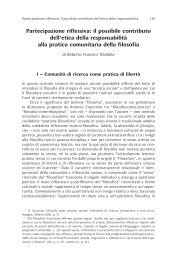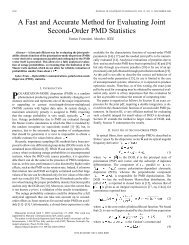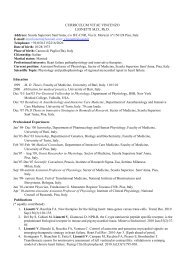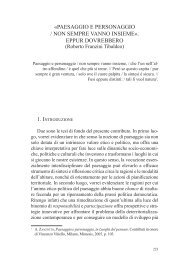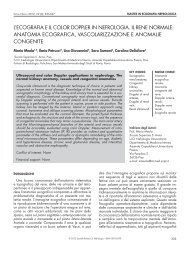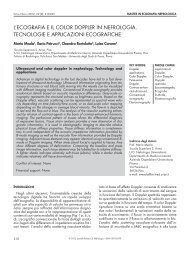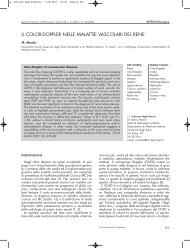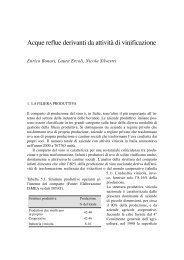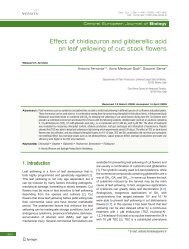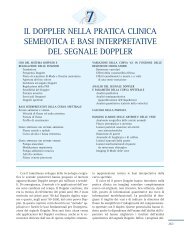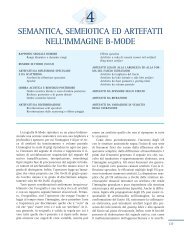Wireless capsule endoscopy: from diagnostic devices to ...
Wireless capsule endoscopy: from diagnostic devices to ...
Wireless capsule endoscopy: from diagnostic devices to ...
Create successful ePaper yourself
Turn your PDF publications into a flip-book with our unique Google optimized e-Paper software.
Biomed Micro<strong>devices</strong> (2007) 9:235–243 239<br />
Fig. 7 Olympus WCE system: EndoCapsule (a) and Real Time<br />
Viewer (b)<br />
Fig. 8 Image of normal villi structure, taken by EndoCapsule: without<br />
(a) and with structure enhancement (b)<br />
Then, the EndoCapsule Software allows the management<br />
of the acquired data. Its main features are: a multi display<br />
function for optimal observation, structure enhancement and<br />
enlargement display function <strong>to</strong> highlight the tiniest details<br />
(Fig. 8), red colour detection function <strong>to</strong> highlight suspected<br />
bleeding symp<strong>to</strong>ms, and au<strong>to</strong> speed adjustment function <strong>to</strong><br />
optimise the review speed Clinical testing is still under way<br />
in the United States and Japan, and the company needs <strong>to</strong><br />
receive full approval before selling its device in these markets<br />
(Fuyuno, 2005).<br />
The efficacy of EndoCapsule was demonstrated During<br />
Digestive Disease Week 2006, in Los Angeles, California<br />
(USA).<br />
Technical limitations<br />
The usage of an internal power source, such as a battery, is<br />
a critical issue as <strong>to</strong> <strong>to</strong>xicity and length. In particular, the<br />
Table 1 Comparison of<br />
existing WCE solutions of<br />
Given Imaging and Olympus<br />
latter sets a limit on the amount of available energy devoted<br />
<strong>to</strong> the acquisition of pictures. This affects the choice of the<br />
image sensor: CMOS technology may be preferable since it<br />
ensures a lower power consumption than CCD, but at a price<br />
of a poorer image quality (Litwiller, 2005).<br />
Moreover, the limited energy provided by a battery makes<br />
it impossible <strong>to</strong> add other functional modules <strong>to</strong> endoscopic<br />
<strong>capsule</strong>s, especially those for the locomotion and control of<br />
movement. If a <strong>capsule</strong> had an active locomotion it could<br />
vary its speed, thus reducing the transit time, and with s<strong>to</strong>p<br />
mechanisms it might stay at a specific point of <strong>diagnostic</strong><br />
interest for a prolonged time. This would enable the physician<br />
<strong>to</strong> conduct a more thorough analysis, whenever he spots<br />
interesting sites. The integration of sensors could also make<br />
other <strong>diagnostic</strong> and therapeutic tasks feasible, e.g. biopsy<br />
and drug delivery.<br />
Table 1 reports a comparison of the WCE which have<br />
received approval for usage in clinical environments.<br />
Future prospects of WCE: better images, therapy and<br />
active locomotion<br />
The importance of image sensors with finer resolution than<br />
current systems is motivated by the need <strong>to</strong> enable the detection<br />
of pathologies at an earlier stage, which are smaller and<br />
for this reason invisible at present. As a consequence, they<br />
may overcome images dis<strong>to</strong>rtion, which recurs during the<br />
zoom of a picture every time an enlarged view is required.<br />
However the higher the resolution, the higher the power consumption<br />
of the RF transmitter. In this sense Lin et al. (2006)<br />
have developed the GICam pill with a low power image compression<br />
processor. On the other hand, if a <strong>capsule</strong> were able<br />
<strong>to</strong> move actively it would decrease the length of its journey.<br />
Furthermore, with the capability <strong>to</strong> s<strong>to</strong>p at specific sites, it<br />
would help the physician <strong>to</strong> perform a thorough diagnosis<br />
in areas of major interest and <strong>to</strong> enable drug release (Raju<br />
et al., 2002). Then, steady advancements in the BioMEMS<br />
field foreshadow <strong>capsule</strong>s with sensors enabling new tasks<br />
(Gourley, 2005).<br />
In this regard, a wireless ingestible <strong>capsule</strong> endowed with<br />
three sensors for the moni<strong>to</strong>ring of pH, temperature and<br />
Given Imaging Olympus<br />
WCE Name PillCam TM SB PillCam TM ESO EndoCapsule<br />
Dimensions (D × L) 11 mm× 26 mm<br />
Operative environment Small intestine Esophagus Small intestine<br />
Image sensor type CMOS CCD<br />
Frame rate 2 images/second 14 images/second 2 images/second<br />
Image acquisition Off line Real time<br />
Power source Internal battery<br />
Source of motion Peristalsis<br />
Springer



